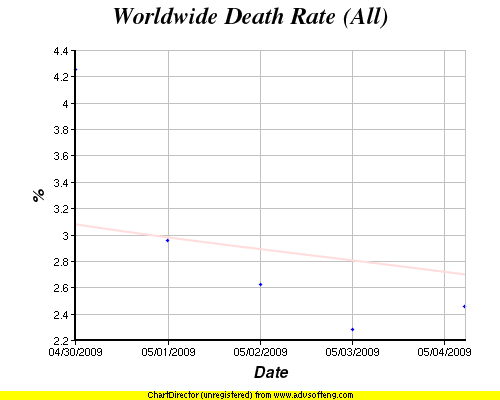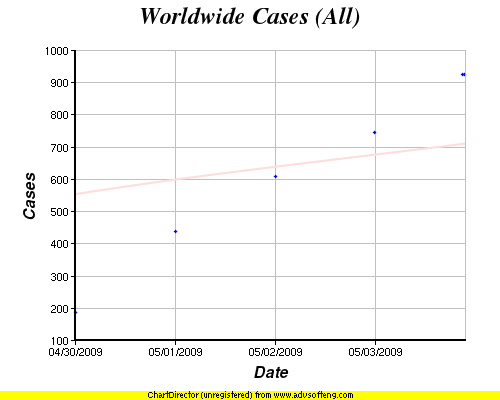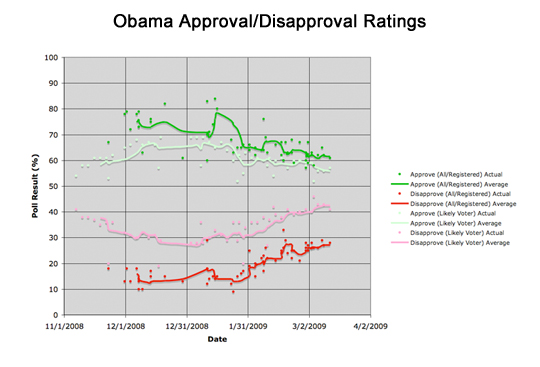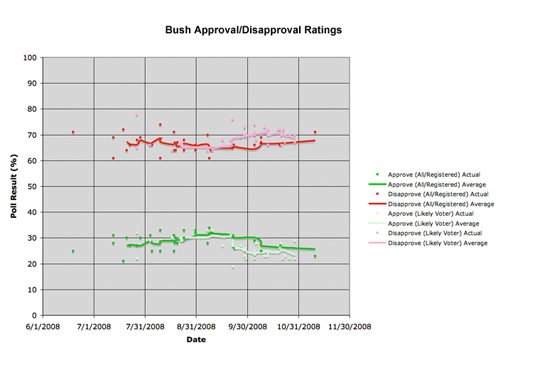I find myself bored waiting for the new daily data points on the Swine Flu Dashboard so I have accelerated data collection from once per day to four times per day (random times within each 6 hour interval) starting in a few hours at 0 UTC.
|
I added death rates (deaths/cases) to the suite of charts on the Swine Flu Dashboard. Still updated once a day at random times, but to make the ratio correct, I now grab the deaths and cases data at the same time of day in each geographic grouping, although worldwide and US will generally be updated at different times. Despite my strong suspicion that this whole thing is over hyped, noticing that most (if not all) places I’ve seen are just giving totals, rather than trends over time, I’ve gone ahead and set up a Swine Flu Dashboard giving charts over time on confirmed cases and deaths on a worldwide and US only basis. The data is taken from Wikipedia for the worldwide numbers (as the way the WHO website presented the data was more difficult to grab) and from the CDC for the US numbers. I got data from the last few days manually, but the charts are now set to update automatically on a daily basis. I’ll leave this going until either it becomes a pain for some reason, or the hype bubble pops and nobody cares any more. Note: Yeah, yeah, H1N1. Whatever. Swine Flu. Just got the CNN Breaking News alert on my phone. Jack Kemp is dead. I remember thinking that he (along with Dole) back in 1996 were decent well meaning folks even if I disagreed with them on a lot. Of course they all have swine flu. Of course they do. Kids Who Cried “Pig”? Suspected Flu Cases Increase
Yum Huh. Obama Denies Bailout Funds For Automakers
Buh Bye! That the total amount of all these stupid bonuses is a tiny tiny fraction of the TRILLIONS we are spending overall in bailouts, stimulus, and crazy stuff the Fed is doing. Even wasting 5 minutes on this is a huge distraction from paying attention to the parts of this that actually matter more and which are REALLY wasting the public’s money. To reiterate… I say just let everything die. A good hard long recession will clear everything out to make room for later generations. Brandy points out that my old email archives (paper archives from the early 90’s from before I had enough hard drive space to store everything) will not fit in the car we would have to live in. So be it. For the record, although I’m sure Ivan and I will talk about it on the next show… I think the AIG bonuses are crazy. But I think the proposed retroactive taxes to take them away from the people who got them are completely and totally wrong and misguided and a horrible horrible precedent. We want a government that feels free to decide after the fact that it doesn’t like that you made the money you made, and then change the rules so that they can take it from you… after you’ve got the money (and quite possibly after you have spent it, not knowing it would be taxed)? Really? We want that? Really? These bonuses were written into contracts that AIG made. They were probably contracts AIG should not have made. But they were already done by the time the bailout happened. They were obligations, just like the other debt obligations AIG had. Of course AIG was going to pay its debts with the bailout money. That is what the bailout was for after all. Duh. And no, we shouldn’t have put strings on the bailout saying that AIG should pay some debts but not others. If we really felt that way, we should not do a bailout at all. Let the damn thing go out of business, then if there are creditors we think deserve it more than others, bail THEM out. All and all, with every turn of every screw in this whole saga, I’m more and more convinced that the “right” thing to do, going back all the way to last fall, is to not have bailed out a damn thing. Not one company, not one industry. Not the financials, not the autos, not nothing. Would we have a worse recession right now if we had? Probably. I won’t try to argue against the folks that say these bailouts were necessary to prevent that from happening. I’ve always had severe reservations though. And at this point I’m thinking that perhaps an extremely severe recession where most of the companies in most of these industries go completely out of business… taking with them all of the other companies… and yes regular people… who depended on them… is really the only way to get the bad blood out of the system. To completely and totally kill (for at least a generation or two, these things always come back) the idea that the bad practices that resulted in the mess are things NOT TO DO. Right now, I don’t see that lesson REALLY being learned. People are just waiting for the tide to turn and then they will go right back to where things were. We need to get back to the point where if you are going to try something, you really do shoulder almost all of the risk for it yourself, rather than trying to bury the risk in layers of insurance products designed to make the risky not risky. Hey, guess what, things are still risky. You’re just moving the risk around and making it harder to see. It does not go away. And maybe insurance makes sense when it is against things which are actuarially highly predictable like death and disease and fender benders… but there should not be insurance against bad business decisions. It just distorts the whole incentive model and encourages people to take on very risky endeavors that are probably best left on the table. How about a little caution and prudence instead? Sure, you don’t get as big an upside, but so what. Anyway, I say bring on the damn depression. Let everything fail. Salt the earth. Perhaps there will be horrible pain for a generation. But what comes after that will be stronger because of it. Trying to prop this crap up MAY be helping things in the short term, but in the long term, it is just propping up businesses and business practices that deserve to fail. Let them die. DIE DIE DIE. Chris Weigant once again uses some graphs I made for him, and some quotes from me, in an article on his site Wednesday. A Surprise In Obama’s Poll Numbers
(Also cross posted at Huffington Post) Chris draws some tentative conclusions from this about there (at least potentially) being a reservoir of extra strong support for Obama among the folks who are in the “All” or “Registered Voter” samples but who are not in the “Likely Voter” samples… perhaps tied to people who were not traditional voters who were “energized” by the Obama campaign and are retaining their excitement. Maybe. But as Chris quotes me in his article, I have my doubts and think it is highly likely that there is a much more pedestrian explanation. The quote of mine Chris gives does hit on the crux of this, but for completeness to get my own thoughts on this out there, let me quote here a bit more of my comments to Chris which he excerpted. (I’ve made some minor edits to fix some wording issues with the original, and to remove other comments not directly relevant.)
Date: 18 March 2009 06:49:08 GMT
And that is that. :-) Another Daily Show bit that will stand out over time. The actual show cut this way down, but the full, unedited, 23 minutes or so, is available online. And we’re left once again asking why “real” news places don’t actually push and prod and question the assumptions everyone makes, etc. It would be nice if that happened sometime. This is played straight too. This isn’t a bunch of laughs. Both Steward and Cramer are dead serious almost the whole time. Speaking of which, I give Cramer a lot of credit for actually coming on this show and taking his spanking. In three parts: (via Oliver Willis and a bunch of other places) |
||



